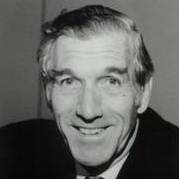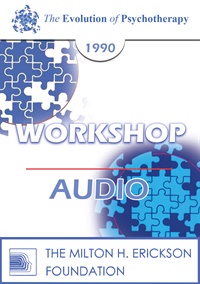EP90 Workshop 26 - Psychotherapy "As If" - Paul Watzlawick, PhD
- Average Rating:
- Not yet rated
- Topic Areas:
- Workshops | Psychotherapy | Brief Therapy | Family Therapy | Reframing | Resistance | Strategic Therapy | Systems Theory
- Categories:
- Evolution of Psychotherapy | Evolution of Psychotherapy 1990 | Pioneers in Couples and Family Therapy
- Faculty:
- Paul Watzlawick, PhD
- Duration:
- 2 Hours 23 Minutes
- Format:
- Audio Only
- Original Program Date:
- Dec 15, 1990
- License:
- Never Expires.
Description
Description:
This workshop will present a brief therapy approach, based on the interaction between those involved in the problem, and on the interventions aimed at changing this problematic interaction by motivating the client(s) to behave "as if" the situation were different from the way it is perceived.
Educational Objectives:
- To show the relevance of Vaihinger's Philosophy of As If and of Korszybski's Science and Sanity to psychotherapy
- To list four examples of practical applications of these principles
*Sessions may be edited for content and to preserve confidentiality*
Outline:
Evolution of Psychotherapy and Introduction to the Presentation
-
Paul Watzlawick begins his presentation, referencing Hans Vaihinger's The Philosophy of As If
-
Vaihinger argues that humans function based on useful fictions (e.g., free will, mathematical points)
-
His idea that “truth is the most expedient error” shocked contemporaries but influenced Alfred Adler
Examples from Vaihinger's Book and Their Implications
-
Legal fiction of freedom: used in sentencing without examining its validity
-
Mathematical point: a non-sensuous abstraction foundational to geometry
-
Truth as expedient error reiterated as useful for therapeutic framing
-
Reference to Korzybski’s Science and Sanity: "The map is not the territory"
Constructivist Epistemology and Its Relevance to Psychotherapy
-
Reality is constructed, not objectively existing
-
Epictetus: "It is not things that worry us, but our opinions about them"
-
Constructivism helps explain mental health phenomena and therapeutic strategies
-
Changing constructed realities is central to therapy
Literary Examples of Relative Reality
-
Hesse’s Steppenwolf: Magic Theater illustrates multiple realities
-
Fowles’ The Magus: protagonist’s understanding of reality is undermined
-
Both demonstrate constructed, not fixed, realities
Theoretical Introduction to Constructivist Epistemology
-
Contrast between objectivism and constructivism
-
Therapy as the transformation of painful constructed realities
-
Joke about the wine bottle (optimist vs. pessimist) used to illustrate differing perspectives
Practical Application of Constructivist Epistemology in Therapy
-
Phobic avoidance illustrates the persistence of maladaptive constructions
-
Four interventions: trust, origin discovery, object introduction, “accident” exposure
-
Corrective emotional experiences can catalyze shifts in perception
Behavior Prescriptions and Systemic Therapy
-
Behavior prescriptions: clients asked to act “as if”
-
Example: fear of a boss resolved through behavioral reframing
-
Systemic therapy focuses on dyadic relationships and emergent qualities
-
Simple interventions often more effective than complex analyses
Variety Reducers and Systemic Interventions
-
Variety reducers help manage complexity (e.g., thermostats, traffic rules)
-
Gauss’s method as a mathematical example
-
Emphasis on small, peripheral therapeutic changes
-
Therapist explores past attempted solutions and advice given
Case Examples and Practical Interventions
-
PTSD client helped by reconnecting with emotional experience
-
Importance of understanding the client’s own framing of the problem
-
Paradoxical interventions used when straightforward methods fail
-
Example: woman compelled to comply with others helped via paradox
Conclusion and Final Thoughts
-
Emphasis on small, ethical, non-intrusive behavioral prescriptions
-
Avoidance of violating client’s moral/religious framework
-
Ethical awareness central to applying constructivist interventions
Positive Connotation Intervention
-
Originated by Mara Selvini Palazzoli
-
Used when clients report prior therapeutic failure
-
Therapist suggests change would make things worse, prompting client to prove them wrong
-
Often evokes change through paradox
Case Study: Whiplash Injury
-
Woman continued to complain post-healing
-
Psychiatrist told her pain wouldn’t go away
-
Despite pessimism, symptoms improved
-
Demonstrates power of reframing through paradox
Behavior Prescription Techniques
-
Prescriptions delivered slowly and with monotony
-
State of expectancy is critical for effectiveness
-
Compliance discussed in follow-up sessions
-
Noncompliance handled with therapist apology and revised directive
Handling Client Compliance
-
Clients may: not follow, misunderstand, or report improvement
-
Therapist should respond accordingly—simplify, reframe, or probe for insight
-
Goal is for client to feel responsible for the change
Preventing Relapses
-
Clients asked to anticipate what could cause relapse
-
Encouraged to proactively plan for preventing it
-
John Rosen’s technique of demonstrating symptoms to others referenced
Termination of Therapy
-
Clear expectations set at the start (e.g., max 10 sessions in brief therapy)
-
In private practice, termination is collaborative
-
Avoid implication that the therapist is “giving up” on the client
Application to Different Cases
-
Not all cases (e.g., psychosis) are suited to the approach
-
Criticisms acknowledged (e.g., superficiality or manipulation)
-
Instead of lecturing on constructivism, therapist uses client’s own framing
-
Example: professor with anticipatory anxiety uses metaphor of pushing safety zone
Externalizing the Problem
-
Inspired by Gregory Bateson’s systems thinking
-
Focus is on how the problem interacts with context and relationships
-
Seen as a broader ecological/systemic issue, not just internal pathology
Handling Addictions
-
Chronic alcoholism addressed via systemic interventions
-
Focus on modifying spouse’s behavior rather than confronting the addict
-
Overeating example: wife’s change prompted husband’s improvement
-
Reference to Herbert Spiegel’s work on tobacco addiction
Consulting with Businesses
-
Corporate consultation parallels family systems therapy
-
Complexity is greater, but principles remain the same
-
Begin by identifying attempted solutions
-
Aim is to resolve systemic dysfunction, not assign individual blame
Credits
Handouts
| Timestamped Transcript (1.3 MB) | 35 Pages | Available after Purchase |
| Ericksonian Learning Snapshot (248.6 KB) | 2 Pages | Available after Purchase |
Faculty

Paul Watzlawick, PhD Related Seminars and Products
Paul Watzlawick, received his Ph.D. from the University of Venice in 1949. He has an Analyst's Diploma from the C.G. Jung Institute for Analytic Psychology in Zurich. Watzlawick has practiced psychotherapy for more than 30 years. He was research associate and principal investigator at the Mental Research Institute. He was Clinical Professor at the Department of Psychiatry and Behavioral Sciences, Stanford University Medical Center. Watzlawick is a noted family therapist; he is recipient of the Distinguished Achievement Award from the American Family Therapy Association. Also, he is author, co-author or editor of eight books on the topics of interactional psychotherapy, human communication and constructivist philosophy.
He formulated five axioms. They are:
- It is not possible to not communicate. Every behavior is some kind of non-verbal communication.
- Every communication has a content. In addition, there is 'metainformation', which says how the communicator wants to be understood.
- All partners involved in a communication process also interpret their own behaviour during communication.
- Human communication involves both verbal and non-verbal communication. In addition to the spoken words, there are is also a non-spoken part (gestures, behavior, intonation..) which is part of the communication.
- Communication between humans is either symmetric or complementary. This is based on whether the relationship of those communicating is based on differences or parity.


